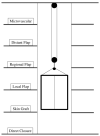Flap reconstruction of the elbow and forearm: a case-based approach
- PMID: 24731607
- PMCID: PMC4011142
- DOI: 10.1016/j.hcl.2013.12.005
Flap reconstruction of the elbow and forearm: a case-based approach
Abstract
Elbow and forearm wounds have distinct reconstructive requirements, but both require a durable and pliable solution. Pedicle, free fasciocutaneous and muscle, and distant (2-stage) flaps have a role in wound reconstruction in these unique areas. This article presents practical surgical cases as a guide to soft tissue reconstruction of the elbow and forearm.
Keywords: Elbow wounds; Flap reconstruction; Forearm wounds.
Copyright © 2014 Elsevier Inc. All rights reserved.
Figures































Similar articles
-
[Anterolateral thigh and groin conjoined flap for emergent repair of ultra-long complex tissue defects in forearm and hand].Zhongguo Xiu Fu Chong Jian Wai Ke Za Zhi. 2013 Aug;27(8):1010-4. Zhongguo Xiu Fu Chong Jian Wai Ke Za Zhi. 2013. PMID: 24171361 Chinese.
-
Free temporoparietal fascial flap for coverage of a large palmar forearm wound after hand replantation.J Reconstr Microsurg. 2001 Aug;17(6):421-3. doi: 10.1055/s-2001-16355. J Reconstr Microsurg. 2001. PMID: 11507688
-
Free peroneal perforator-based sural neurofasciocutaneous flaps for reconstruction of hand and forearm.Chin Med J (Engl). 2009 Jul 20;122(14):1621-4. Chin Med J (Engl). 2009. PMID: 19719961
-
Soft-tissue coverage for the elbow.Hand Clin. 1997 May;13(2):291-302. Hand Clin. 1997. PMID: 9136042 Review.
-
Soft-tissue coverage of the elbow.Plast Reconstr Surg. 2013 Sep;132(3):387e-402e. doi: 10.1097/PRS.0b013e31829ae29f. Plast Reconstr Surg. 2013. PMID: 23985651 Review.
Cited by
-
Reconstruction of post-traumatic upper extremity soft tissue defects with pedicled flaps: An algorithmic approach to clinical decision making.Chin J Traumatol. 2018 Dec;21(6):338-351. doi: 10.1016/j.cjtee.2018.04.005. Epub 2018 Nov 5. Chin J Traumatol. 2018. PMID: 30579714 Free PMC article.
-
Upper limb traumatic injuries: A concise overview of reconstructive options.Ann Med Surg (Lond). 2021 May 27;66:102418. doi: 10.1016/j.amsu.2021.102418. eCollection 2021 Jun. Ann Med Surg (Lond). 2021. PMID: 34141410 Free PMC article. Review.
-
Microsurgical Reconstruction with and without Microvascular Anastomosis of Oncological Defects of the Upper Limb.Healthcare (Basel). 2024 Oct 15;12(20):2043. doi: 10.3390/healthcare12202043. Healthcare (Basel). 2024. PMID: 39451458 Free PMC article.
-
Soft tissue coverage of the upper limb: A flap reconstruction overview.Ann Med Surg (Lond). 2020 Nov 6;60:338-343. doi: 10.1016/j.amsu.2020.10.069. eCollection 2020 Dec. Ann Med Surg (Lond). 2020. PMID: 33224487 Free PMC article. Review.
-
Simultaneous reconstruction of the forearm extensor compartment tendon, soft tissue, and skin.Arch Plast Surg. 2018 Sep;45(5):479-483. doi: 10.5999/aps.2017.01802. Epub 2018 Sep 15. Arch Plast Surg. 2018. PMID: 30282421 Free PMC article.
References
-
- Giele H. Soft tissue coverage around the elbow. In: Stanley D, Trail I, editors. Operative Elbow Surgery: Expert Consult. Churchill Livingstone; London, England: 2012. p. 719.
-
- Sharpe F, Stevanovic M, Itamura JM. Soft tissue coverage of the elbow. In: Mirzayan R, Itamura JM, editors. Shoulder and Elbow Trauma. Thieme; New York, NY: 2004. p. 89.
-
- Stevanovic M, Sharpe F. Soft-tissue coverage of the elbow. Plast Reconstr Surg. 2013 Sep;132(3):387e–402e. - PubMed
-
- Jensen M, Moran SL. Soft tissue coverage of the elbow: a reconstructive algorithm. Orthop Clin North Am. 2008 Apr;39(2):251–64. vii. - PubMed
-
- Levin LS. The reconstructive ladder. An orthoplastic approach. Orthop Clin North Am. 1993 Jul;24:393–409. - PubMed
Publication types
MeSH terms
Grants and funding
LinkOut - more resources
Full Text Sources
Other Literature Sources
Medical

